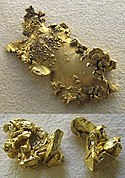|
||||||||||||||||||||||||||||||||||||||||
| General | ||||||||||||||||||||||||||||||||||||||||
|---|---|---|---|---|---|---|---|---|---|---|---|---|---|---|---|---|---|---|---|---|---|---|---|---|---|---|---|---|---|---|---|---|---|---|---|---|---|---|---|---|
| Name, Symbol, Number | gold, Au, 79 | |||||||||||||||||||||||||||||||||||||||
| Chemical series | transition metals | |||||||||||||||||||||||||||||||||||||||
| Group, Period, Block | 11, 6, d | |||||||||||||||||||||||||||||||||||||||
| Appearance | metallic yellow |
|||||||||||||||||||||||||||||||||||||||
| Standard atomic weight | 196.966569(4) g·mol�'1 | |||||||||||||||||||||||||||||||||||||||
| Electron configuration | [Xe] 4f14 5d10 6s1 | |||||||||||||||||||||||||||||||||||||||
| Electrons per shell | 2, 8, 18, 32, 18, 1 | |||||||||||||||||||||||||||||||||||||||
| Physical properties | ||||||||||||||||||||||||||||||||||||||||
| Phase | solid | |||||||||||||||||||||||||||||||||||||||
| Density (near r.t.) | 19.3 g·cm�'3 | |||||||||||||||||||||||||||||||||||||||
| Liquid density at m.p. | 17.31 g·cm�'3 | |||||||||||||||||||||||||||||||||||||||
| Melting point | 1337.33 K (1064.18 °C, 1947.52 °F) |
|||||||||||||||||||||||||||||||||||||||
| Boiling point | 3129 K (2856 °C, 5173 °F) |
|||||||||||||||||||||||||||||||||||||||
| Heat of fusion | 12.55 kJ·mol�'1 | |||||||||||||||||||||||||||||||||||||||
| Heat of vaporization | 324 kJ·mol�'1 | |||||||||||||||||||||||||||||||||||||||
| Heat capacity | (25 °C) 25.418 J·mol�'1·K�'1 | |||||||||||||||||||||||||||||||||||||||
|
||||||||||||||||||||||||||||||||||||||||
| Atomic properties | ||||||||||||||||||||||||||||||||||||||||
| Crystal structure | cubic face centered | |||||||||||||||||||||||||||||||||||||||
| Oxidation states | �'1, 1, 2, 3, 4, 5 (amphoteric oxide) |
|||||||||||||||||||||||||||||||||||||||
| Electronegativity | 2.54 (Pauling scale) | |||||||||||||||||||||||||||||||||||||||
| Ionization energies | 1st: 890.1 kJ/mol | |||||||||||||||||||||||||||||||||||||||
| 2nd: 1980 kJ/mol | ||||||||||||||||||||||||||||||||||||||||
| Atomic radius | 135 pm | |||||||||||||||||||||||||||||||||||||||
| Atomic radius (calc.) | 174 pm | |||||||||||||||||||||||||||||||||||||||
| Covalent radius | 144 pm | |||||||||||||||||||||||||||||||||||||||
| Van der Waals radius | 166 pm | |||||||||||||||||||||||||||||||||||||||
| Miscellaneous | ||||||||||||||||||||||||||||||||||||||||
| Magnetic ordering | diamagnetic | |||||||||||||||||||||||||||||||||||||||
| Electrical resistivity | (20 °C) 22.14 n Ω·m | |||||||||||||||||||||||||||||||||||||||
| Thermal conductivity | (300 K) 318 W·m�'1·K�'1 | |||||||||||||||||||||||||||||||||||||||
| Thermal expansion | (25 °C) 14.2 µm·m�'1·K�'1 | |||||||||||||||||||||||||||||||||||||||
| Speed of sound (thin rod) | (r.t.) (hard-drawn) 2030 m·s�'1 |
|||||||||||||||||||||||||||||||||||||||
| Young's modulus | 78 GPa | |||||||||||||||||||||||||||||||||||||||
| Tensile Strain | 0.00157 | |||||||||||||||||||||||||||||||||||||||
| Shear modulus | 27 GPa | |||||||||||||||||||||||||||||||||||||||
| Bulk modulus | 220 GPa | |||||||||||||||||||||||||||||||||||||||
| Poisson ratio | 0.44 | |||||||||||||||||||||||||||||||||||||||
| Mohs hardness | 2.5 | |||||||||||||||||||||||||||||||||||||||
| Vickers hardness | 216 MPa | |||||||||||||||||||||||||||||||||||||||
| Brinell hardness | ? 2450 MPa | |||||||||||||||||||||||||||||||||||||||
| CAS registry number | 7440-57-5 | |||||||||||||||||||||||||||||||||||||||
| Selected isotopes | ||||||||||||||||||||||||||||||||||||||||
|
||||||||||||||||||||||||||||||||||||||||
| References | ||||||||||||||||||||||||||||||||||||||||
Gold( 79) is a chemical element with the symbol Au (from the Latin aurum, meaning shining dawn) and atomic number 79. It is a highly sought-after precious metal which, for many centuries, has been used as money, a store of value and in jewelry. The metal occurs as nuggets or grains in rocks, underground "veins" and in alluvial deposits. It is one of the coinage metals. Gold is dense, soft, shiny and the most malleable and ductile of the known metals. Pure gold has a bright yellow color traditionally considered attractive.
Gold formed the basis for the gold standard used before the fiat currency monetary system was employed by the International Monetary Fund (IMF) and the Bank for International Settlements (BIS). It is specifically against IMF regulations to base any currency against gold for all IMF member states, however currencies may be based on oil though such as the OPEC Petrodollar. The ISO currency code of gold bullion is XAU.
Modern industrial uses include dentistry and electronics, where gold has traditionally found use because of its good resistance to oxidative corrosion.
Chemically, gold is a trivalent and univalent transition metal. Gold does not react with most chemicals, but is attacked by chlorine, fluorine, aqua regia and cyanide. Gold dissolves in mercury, forming amalgam alloys, but does not react with it. Gold is insoluble in nitric acid, which will dissolve silver and base metals, and this is the basis of the gold refining technique known as "inquartation and parting". Nitric acid has long been used to confirm the presence of gold in items, and this is the origin of the colloquial term "acid test," referring to a gold standard test for genuine value.
Contents |
Characteristics
Gold is the most malleable and ductile metal; a single gram can be beaten into a sheet of one square meter, or an ounce into 300 square feet. Gold leaf can be beaten thin enough to become translucent. The transmitted light appears greenish blue, because gold strongly reflects yellow and red. Gold readily forms alloys with many other metals. These alloys can be produced to increase the hardness or to create exotic colors (see below). Native gold contains usually eight to ten percent silver, but often much more �" alloys with a silver content over 20% are called electrum. As the amount of silver increases, the color becomes whiter and the specific gravity becomes lower.
Gold is a good conductor of heat and electricity, and is not affected by air and most reagents. Heat, moisture, oxygen, and most corrosive agents have very little chemical effect on gold, making it well-suited for use in coins and jewelry; conversely, halogens will chemically alter gold, and aqua regia dissolves it via formation of the chloraurate ion.
Common oxidation states of gold include +1 (gold(I) or aurous compounds) and +3 (gold(III) or auric compounds). Gold ions in solution are readily reduced and precipitated out as gold metal by adding any other metal as the reducing agent. The added metal is oxidized and dissolves allowing the gold to be displaced from solution and be recovered as a solid precipitate.
Recent research undertaken by Sir Frank Reith of the Australian National University shows that microbes play an important role in forming gold deposits, transporting and precipitating gold to form grains and nuggets that collect in alluvial deposits.[1]
High quality pure metallic gold is tasteless, in keeping with its resistance to corrosion (it is metal ions which confer taste to metals).
In addition, gold is very dense, a cubic meter weighing 19300 kg. By comparison, the density of lead is 11340 kg/m³, and the densest element, Iridium, is 22650 kg/m³.
Applications
As the metal
Medium of monetary exchange
In various countries, gold is used as a standard for monetary exchange, in coinage and in jewelry. Pure gold is too soft for ordinary use and is typically hardened by alloying with copper or other base metals. The gold content of gold alloys is measured in carats (k), pure gold being designated as 24k.
Gold coins intended for circulation from 1526 into the 1930s were typically a standard 22k alloy called crown gold, for hardness. Modern collector/investment bullion coins (which do not require good mechanical wear properties) are typically 24k, although the American Gold Eagle and British gold sovereign continue to be made at 22k, on historical tradition. The Canadian Gold Maple Leaf coin contains the highest purity gold of any popular bullion coin, at 99.999% (.99999 fine). Several other 99.99% pure gold coins are currently available, including Australia's Gold Kangaroos (first appearing in 1986 as the Australian Gold Nugget, with the kangaroo theme appearing in 1989), the several coins of the Australian Lunar Calendar series, and the Austrian Philharmonic. In 2006, the U.S. Mint began production of the American Buffalo gold bullion coin also at 99.99% purity.
Today, gold has fallen out of use in coins made for general circulation.
Jewelry
Because of the softness of pure (24k) gold, it is usually alloyed with base metals for use in jewelry, altering its hardness and ductility, melting point, color and other properties. Alloys with lower "k", typically 22k, 18k, 14k or 10k, contain higher percentages of copper, silver or other base metals in the alloy. Copper is the most commonly used base metal, yielding a redder metal. Eighteen carat gold containing 25% copper is found in antique and Russian jewelry and has a distinct, though not dominant, copper cast, creating rose gold. Fourteen carat gold-copper alloy is nearly identical in color to certain bronze alloys, and both may be used to produce police and other badges. Blue gold can be made by alloying with iron and purple gold can be made by alloying with aluminum, although rarely done except in specialized jewelry. Blue gold is more brittle and therefore more difficult to work with when making jewelry. Fourteen and eighteen carat gold alloys with silver alone appear greenish-yellow and are referred to as green gold. White gold alloys can be made with palladium or nickel. White 18 carat gold containing 17.3% nickel, 5.5% zinc and 2.2% copper is silver in appearance. Nickel is toxic, however, and its release from nickel white gold is controlled by legislation in Europe. Alternative white gold alloys are available based on palladium, silver and other white metals (World Gold Council), but the palladium alloys are more expensive than those using nickel. High-carat white gold alloys are far more resistant to corrosion than are either pure silver or sterling silver. The Japanese craft of Mokume-gane exploits the colour contrasts between laminated colored gold alloys to produce decorative wood-grain effects.
Other
- In medieval times, gold was often seen as beneficial for the health, in the belief that something that rare and beautiful could not be anything but healthy. Even some modern esotericists and forms of alternative medicine assign metallic gold a healing power. Some gold salts do have anti-inflammatory properties and are used as pharmaceuticals in the treatment of arthritis and other similar conditions. However, only salts and radioisotopes of gold are of pharmacological value, as elemental (metallic) gold is inert to all chemicals it encounters inside the body.
- Gold leaf, flake or dust is used on and in some gourmet foodstuffs, notably sweets and drinks as decorative ingredient.[2] Gold flake was used by the nobility in Medieval Europe as a decoration in foodstuffs and drinks, in the form of leafs, flakes or dust, either to demonstrate the host's wealth or in the belief that something that valuable and rare must be beneficial for one's health.
- Gold solder is used for joining the components of gold jewelry by high-temperature hard soldering or brazing. If the work is to be of hallmarking quality, gold solder must match the carat weight of the work, and alloy formulae are manufactured in most industry-standard carat weights to color match yellow and white gold. Gold solder is usually made in at least three melting-point ranges referred to as Easy, Medium and Hard. By using the hard, high-melting point solder first, followed by solders with progressively lower melting points, goldsmiths can assemble complex items with several separate soldered joints.
- Gold can be used in food and has the E Number 175. Goldwasser (German: "Goldwater") is a traditional herbal liqueur produced in Gdańsk, Poland and Schwabach, Germany and contains flakes of gold leaf. There are also some expensive (~$1000) cocktails which contain flakes of gold leaf[citation needed]. However, since metallic gold is inert to all body chemistry, it adds no taste nor has it any other nutritional effect and leaves the body unaltered.
- Dentistry. Gold alloys are used in restorative dentistry, especially in tooth restorations, such as crowns and permanent bridges. The gold alloys' slight malleability facilitates the creation of a superior molar mating surface with other teeth and produces results that are generally more satisfactory than those produced by the creation of porcelain crowns. The use of gold crowns in more prominent teeth such as incisors is favored in some cultures and discouraged in others.
- Gold can be made into thread and used in embroidery.
- Gold is ductile and malleable, meaning it can be drawn into very thin wire and can be beaten into very thin sheets known as gold leaf.
- Gold produces a deep, intense red color when used as a coloring agent in cranberry glass.
- In photography, Gold toners are used to shift the color of silver bromide black and white prints towards brown or blue tones, or to increase their stability. Used on sepia-toned prints, gold toners produce red tones. Kodak publish formulae for several types of gold toners, which use gold as the chloride (Kodak, 2006).
- Electronics. The concentration of free electrons in gold metal is 5.90×1022 cm-3. Gold is highly conductive to electricity, and has been used for electrical wiring in some high energy applications (silver is even more conductive per volume, but gold has the advantage of corrosion resistance). For example, gold electrical wires were used during some of the Manhattan Project's atomic experiments, but large high current silver wires were used in the calutron isotope separator magnets in the project.
- Though gold is attacked by free chlorine, its good conductivity and general resistance to oxidation and corrosion in other environments (including resistance to non-chlorinated acids) has led to its widespread industrial use in the electronic era as a thin layer coating electrical connectors of all kinds, thereby ensuring good connection. For example, gold is used in the connectors of the more expensive electronics cables, such as audio, video and USB cables. The benefit of using gold over other connector metals such as tin in these applications, is highly debated. Gold connectors are often criticized by audio-visual experts as unnecessary for most consumers and seen as simply a marketing ploy. However, the use of gold in other applications in electronic sliding contacts in highly humid or corrosive atmospheres, and in use for contacts with a very high failure cost (certain computers, communications equipment, spacecraft, jet aircraft engines) remains very common, and is unlikely to be replaced in the near future by any other metal.
- Besides sliding electrical contacts, gold is also used in electrical contacts because of its resistance to corrosion, electrical conductivity, ductility and lack of toxicity. Switch contacts are generally subjected to more intense corrosion stress than are sliding contacts.
As gold chemical compounds
Gold is attacked by and dissolves in alkaline solutions of potassium or sodium cyanide, and gold cyanide is the electrolyte used in commercial electroplating of gold onto base metals and electroforming. Gold chloride (chloroauric acid) solutions are used to make colloidal gold by reduction with citrate or ascorbate ions. Gold chloride and gold oxide are used to make highly-valued cranberry or red-colored glass, which, like colloidal gold sols, contains evenly-sized spherical gold nanoparticles.
Production
Economic gold extraction can be achieved from ore grades as little as 0.5 g/1000 kg (0.5 parts per million, ppm) on average in large easily mined deposits. Typical ore grades in open-pit mines are 1�"5 g/1000 kg (1�"5 ppm), ore grades in underground or hard rock mines are usually at least 3 g/1000 kg (3 ppm) on average. Since ore grades of 30 g/1000 kg (30 ppm) are usually needed before gold is visible to the naked eye, in most gold mines the gold is invisible.
Since the 1880s, South Africa has been the source for a large proportion of the world’s gold supply, with about 50% of all gold ever produced having come from South Africa. Production in 1970 accounted for 79% of the world supply, producing about 1,000 tonnes. However by 2005 production was just 294 tonnes according to the British Geological Survey. This sharp decline was due to the increasing difficulty of extraction and changing economic factors affecting the industry in South Africa.
The city of Johannesburg located in South Africa was founded as a result of the Witwatersrand Gold Rush which resulted in the discovery of some of the largest gold deposits the world has ever seen. Gold fields located within the basin in the Free State and Gauteng provinces are extensive in strike and dip requiring some of the world's deepest mines, with the Savuka and TauTona mines being currently the world's deepest gold mine at 3,777 m. The Second Boer War of 1899�"1901 between the British Empire and the Afrikaner Boers was at least partly over the rights of miners and possession of the gold wealth in South Africa.
Other major producers are United States, Australia, China, Russia and Peru. Mines in South Dakota and Nevada supply two-thirds of gold used in the United States. In South America, the controversial project Pascua Lama aims at exploitation of rich fields in the high mountains of Atacama Desert, at the border between Chile and Argentina. Today about one-quarter of the world gold output is estimated to originate from artisanal or small scale mining.[11]
After initial production, gold is often subsequently refined industrially by the Wohlwill process or the Miller process. Other methods of assaying and purifying smaller amounts of gold include parting and inquartation as well as cuppelation, or refining methods based on the dissolution of gold in aqua regia.
The world's oceans hold a vast amount of gold, but in very low concentrations (perhaps 1�"2 parts per 10 billion). A number of people have claimed to be able to economically recover gold from sea water, but so far they have all been either mistaken or crooks. Reverend Prescott Jernegan ran a gold-from seawater swindle in America in the 1890s. A British fraud ran the same scam in England in the early 1900s.[12]
Fritz Haber (the German inventor of the Haber process) attempted commercial extraction of gold from sea water in an effort to help pay Germany's reparations following the First World War. Unfortunately, his assessment of the concentration of gold in sea water was unduly high, probably due to sample contamination. The effort produced little gold and cost the German government far more than the commercial value of the gold recovered. No commercially viable mechanism for performing gold extraction from sea water has yet been identified. Gold synthesis is not economically viable and is unlikely to become so in the foreseeable future.
The average gold mining and extraction costs are $238 per troy ounce but these can vary widely depending on mining type and ore quality. In 2001, global mine production amounted to 2,604 tonnes, or 67% of total gold demand in that year. At the end of 2001, it was estimated that all the gold ever mined totalled 145,000 tonnes.[13]
At current consumption rates, the supply of gold is believed to last 45 years.[14]
Price
Like other precious metals, gold is measured by troy weight and by grams. When it is alloyed with other metals the term carat or karat is used to indicate the amount of gold present, with 24 karats being pure gold and lower ratings proportionally less. The purity of a gold bar can also be expressed as a decimal figure ranging from 0 to 1, known as the millesimal fineness, such as 0.995 being very pure.
The price of gold is determined on the open market, but a procedure known as the Gold Fixing in London, originating in September 1919, provides a daily benchmark figure to the industry. The afternoon fixing appeared in 1968 to fix a price when US markets are open.
The high price of gold is due to its rare amount. Only three parts out of every billion (0.000000003) in the Earth's crust is gold.
Historically gold was used to back currency; in an economic system known as the gold standard, a certain weight of gold was given the name of a unit of currency. For a long period, the United States government set the value of the US dollar so that one troy ounce was equal to $20.67 ($664.56/kg), but in 1934 the dollar was revalued to $35.00 per troy ounce ($1125.27/kg). By 1961 it was becoming hard to maintain this price, and a pool of US and European banks agreed to manipulate the market to prevent further currency devaluation against increased gold demand.
On 17 March 1968, economic circumstances caused the collapse of the gold pool, and a two-tiered pricing scheme was established whereby gold was still used to settle international accounts at the old $35.00 per troy ounce ($1.13/g) but the price of gold on the private market was allowed to fluctuate; this two-tiered pricing system was abandoned in 1975 when the price of gold was left to find its free-market level. Central banks still hold historical gold reserves as a store of value although the level has generally been declining. The largest gold depository in the world is that of the U.S. Federal Reserve Bank in New York, which holds about 3% of the gold ever mined, as does the similarly-laden U.S. Bullion Depository at Fort Knox.
In 2005 the World Gold Council estimated total global gold supply to be 3,859 tonnes and demand to be 3,754 tonnes, giving a surplus of 105 tonnes.[15]
Price records
Since 1968 the price of gold on the open market has ranged widely, from a high of $850/oz ($27,300/kg) on 21 January 1980, to a low of $252.90/oz ($8,131/kg) on 21 June 1999 (London Gold Fixing).[16] The 1980 high was not overtaken until 3 January 2008 when a new record of $865.35 per troy ounce was set in the a.m. London Gold Fixing.[17] On January 10, 2008, gold futures for February delivery was $884 on the New York Mercantile Exchange, erasing by $10 the previous record of $875 in 1980, and later it settled at $880.30.[18]
Toxicity
Pure gold is non-toxic and non-irritating when ingested[23] and is sometimes used as a food decoration in the form of gold leaf. It is also a component of the alcoholic drinks Goldschläger, Gold Strike, and Goldwasser. Gold is approved as a food additive in the EU (E175 in the Codex Alimentarius).
Soluble compounds (gold salts) such as potassium gold cyanide, used in gold electroplating, are toxic to the liver and kidneys. There are rare cases of lethal gold poisoning from potassium gold cyanide. Gold toxicity can be ameliorated with chelating agents such as British anti-Lewisite.

GOLD PROSPECTING FOR BEGINNERS
- Basics of Successful Gold Mining, Part 1
- The Basics of Successful Gold Mining, Part 2
- Basics of Successful Gold Mining, Part 3

GOLD PROSPECTING INFORMATION ARTICLES
- Application is the Key to Success
- Capturing Gold Nuggets
- Classification of Material in Sluicing
- Cleaning-up
- Cold Water Dredging
- Crevicing
- Gold Panning Instructions
- Logistical Planning
- Outfitting a Suction Dredging Project
- Setting Up the Proper Recovery System
- Dredging is Hard Work
- The Game of Gold Mining
- Each Problem Presents a Wonderful Opportunity
- Tuning into the Wavelength of Success
- The Devotion of Time
- Prospecting & Treasure Hunting is Never Boring
- Starting Your Season
- Disability and the Miner
- Never Give Up Hope!
- The Preliminary Evaluation
- Different Kinds of Sampling
- Defining Acceptable Ground
- Major Storms & Pay streaks
- Prospecting For Gold in Hard-packed Streambeds
- Fight the Gold Bug with Sampling
- The High Mountain Prospector
- Winter Prospecting in the Siskiyou Mountains
- Placer Gold Deposits
- Treasure Fever
- How to Do Your Research
- Mistakes Novice Placer Miners Make
- Prospecting & TH'ing is Never Boring
- Every Material Thing in Our Lives Came Out of the Ground
- Pocket Hunting for Gold
- A Panning Bonanza
- Digging for Gold
- The Size of Riffles
- How to Crevice for Gold
- Dry Land Dredging
- Suction Dredging for Gold
- Dredging Tips
- Production Gold Dredging
- Teamwork in Production Gold Dredging
- Watch Out for the Bedrock
- Knocking out Plugups
- Your Airline is an Extension of Your Life
- Fast Water Dredging
- Flipping Dredges Over
- Moving Boulders with a Floating Winch
- Shoot Your Gold
- Getting Your Dredging Equipment Ready for the Season
- Pickle That Engine
- Electronic Treasure Hunting
- War of the Golden Word
- Nugget Hunting
- Tips for Detecting Gold Nuggets
- History of Treasure & Gold Detectors
- Noise is Good
- Look for Gold Where You Know It Is
- The Midas Touch
- Electronic Prospecting for Gold
- Dry Washing; or Introduction to the Blister-end of a Shovel
- Puffing for Gold
- Dry Land Dredging
- Drywashing, Deserts & Snowmen
- Good Gold
- When to Clean-up a Sluice Box
- Streamlining Clean-up
- Making Final Clean-up Go Faster
- Liberating Gold from Black Sand
- What to do with Your Gold
- Making Gold Nugget Jewelry

GOLD PROSPECTING INFORMATION ARTICLES


Page Manager...Indiana
Top of page
Contributing information and images: Courtesy of Wikipedia.
Reproduced under GPL license:Click here to view license::
copyright: rockhoundstation1.com 2008
Rock Hound Station 1
Global Rockhound Community





















